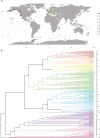Ancestry testing of "Old Tom," a killer whale central to mutualistic interactions with human whalers
- PMID: 37821799
- PMCID: PMC10650950
- DOI: 10.1093/jhered/esad058
Ancestry testing of "Old Tom," a killer whale central to mutualistic interactions with human whalers
Abstract
Cooperative hunting between humans and killer whales (Orcinus orca) targeting baleen whales was reported in Eden, New South Wales, Australia, for almost a century. By 1928, whaling operations had ceased, and local killer whale sightings became scarce. A killer whale from the group, known as "Old Tom," washed up dead in 1930 and his skeleton was preserved. How these killer whales from Eden relate to other populations globally and whether their genetic descendants persist today remains unknown. We extracted and sequenced DNA from Old Tom using ancient DNA techniques. Genomic sequences were then compared with a global dataset of mitochondrial and nuclear genomes. Old Tom shared a most recent common ancestor with killer whales from Australasia, the North Atlantic, and the North Pacific, having the highest genetic similarity with contemporary New Zealand killer whales. However, much of the variation found in Old Tom's genome was not shared with these widespread populations, suggesting ancestral rather than ongoing gene flow. Our genetic comparisons also failed to find any clear descendants of Tom, raising the possibility of local extinction of this group. We integrated Traditional Custodian knowledge to recapture the events in Eden and recognize that Indigenous Australians initiated the relationship with the killer whales before European colonization and the advent of commercial whaling locally. This study rectifies discrepancies in local records and provides new insight into the origins of the killer whales in Eden and the history of Australasian killer whales.
Keywords: Indigenous knowledge; cetaceans; human-wildlife cooperation; mutualism; phylogenomics; whaling.
© The American Genetic Association. 2023.
Figures





References
-
- Baird RW, Whitehead H.. Social organization of mammal-eating killer whales: group stability and dispersal patterns. Can J Zool. 2000:78:2096–2105.
-
- Ban NC, Frid A, Reid M, Edgar B, Shaw D, Siwallace P.. Incorporate Indigenous perspectives for impactful research and effective management. Nat Ecol Evol. 2018:2:1680–1683. - PubMed
-
- Brierly O. Sir Oswald Walters Brierly diary. Eden, New South Wales, 1844–1851:3–4.
-
- Chang JT. Recent common ancestors of all present-day individuals. Adv Appl Probab. 1999:31:1002–1026.
Publication types
MeSH terms
Grants and funding
LinkOut - more resources
Full Text Sources

